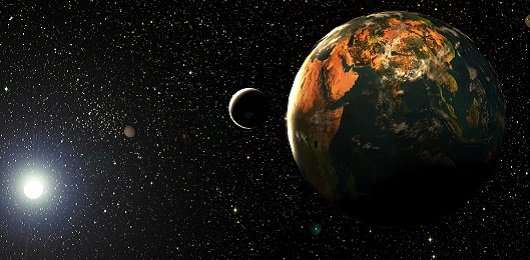Earth holds the key to detecting life beyond our solar system

New research in to how Earth's atmosphere evolved over time could hold the key to detecting life on exoplanets, according to scientists from the University of St Andrews and Cornell University.
The new study, published in The Astrophysical Journal, details how Earth's atmosphere evolved over time and how this corresponds to the appearance of different forms of life.
The team, led by Dr. Sarah Rugheimer, astronomer and astrobiologist from the School of Earth and Environmental Sciences at the University, studied different geological epochs from Earth's history, modelling the atmospheres around different stars, bigger and smaller than our Sun. The researchers found that a planet's star type is an important factor in how an exoplanet's atmosphere develops and in how detectable signs of life, aka biosignatures, will be.
The study focused on Earth's atmosphere at four distinct points in history: before microbes (3.9 billion years ago), after microbes and the first rise of oxygen (2 billion years ago), during the second rise of oxygen (800 million years ago), and Earth as it is today. At each of these points, oxygen, methane and carbon dioxide were in drastically different abundances.
The new findings in to how life evolves in different atmospheres could lay the foundation for scientists to interpret early biosignatures and signs of life on Earth-size exoplanets.
Lead researcher Dr. Rugheimer said: "We expect to find a myriad of exoplanets beyond even our wildest imagination. Even looking back at our own planet, the atmosphere has changed dramatically many times. By looking at the history of Earth and how different host star light would interact with a planet's atmosphere, we can start to create a grid of models to help us understand future observations. In particular, in this paper we wanted to find out how detectable biosignature gases have been both in Earth's history and if these planets were orbiting a different star."
Varied cloud cover and surface features such as oceans and continents were also factored in during the study to see how these affected the models, however in order to accurately reflect the findings on distant exoplanets larger telescopes are required.
Dr. Rugheimer notes: "The 2019 launch of the James Webb Space Telescope should allow us to study a handful of habitable, Earth-size exoplanets transiting red dwarf stars. The European Extremely Large Telescope, which should be online in the mid-2020s, may also be able to directly image a handful of exoplanets."
The paper 'Spectra of Earth-like planets through geological evolution around FGKM stars' by Dr Sarah Rugheimer and Professor Lisa Kaltenegger is published in The Astrophysical Journal.
More information: S. Rugheimer et al. Spectra of Earth-like Planets through Geological Evolution around FGKM Stars, The Astrophysical Journal (2018). DOI: 10.3847/1538-4357/aaa47a , arxiv.org/abs/1712.10027
Journal information: Astrophysical Journal
Provided by University of St Andrews



















